The image of a noble, strong and brave Indian has attracted children for centuries, which is why the costume of a native of North and South America can often be seen at children's parties and New Year's parties. Make this costume yourself for a boy or a girl it will not be difficult even for those who do not know how to sew.
Design features and color palette
The traditions of the national clothing of North and South American Indians were developed over centuries and depended on the lifestyle and region of the tribe. Many Indians were hunters, so clothing was mainly made from the skins of bison, antelope or deer.
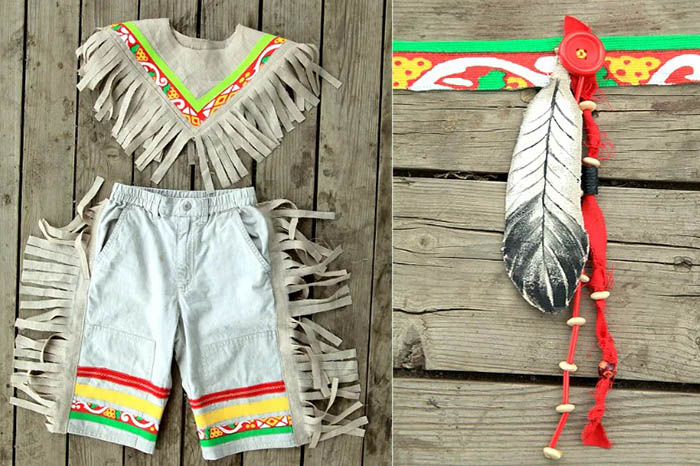
The Indians were able to process the skins so carefully that they became thin and soft, while remaining durable.
Depending on the region of residence, the men's clothing set included:
- leather shirt;
- 2 separately sewn trousers that were fastened at the waist;
- belt;
- cape (poncho).
Indian clothing was decorated with embroidered ornaments, fringe made of thinly cut leather strips, feathers and beads. The amount of decoration on a man's clothing was determined by his success in battle or hunting.
On holidays, for rituals and ceremonies, men wore headdresses, their appearance depended on who was considered the patron of the tribe - a bear, a raven, a wolf, an eagle. The most famous male headdress is called War bonnet, or military bonnet. It was a headdress made of several rows of large feathers, and its length could reach the floor.
The war bonnet was made from carefully selected golden eagle feathers. Only chieftains and prominent warriors were allowed to wear such decoration on holidays.

The rest of the warriors wore a Roach on their heads – a bunch of porcupine quills or a piece of horse, elk or deer skin, fixed in the form of a comb. Indians often did Roach hairstyles, shaving their hair and leaving only a comb. In everyday life, a large eagle feather, fixed on a headband, was often used to decorate the hair.
Women's attire was no less colorful: it included a shirt with a long skirt or a dress made of 2 skins, with a petticoat or pants worn underneath. All clothing was decorated with shells, animal teeth and claws, pieces of wool, beads, fringe, embroidery, coins and feathers.
On their feet, the Indians wore moccasins - soft leather slippers, also richly decorated. In pairs with moccasins, leggings - knee-length gaiters - were often used. Indian attire was complemented by various decorations - beads on the neck, necklaces, bracelets, rings.
The hairstyles of men and women were the same - long loose hair was tied at the forehead with a bandage or a belt, and two braids were also often braided.
The Indian costume for a boy will look like a real one if you take suitable materials of the corresponding palette for its creation. The Indian costume was distinguished by a natural color scheme, so for work you will need materials of beige and brown tones.
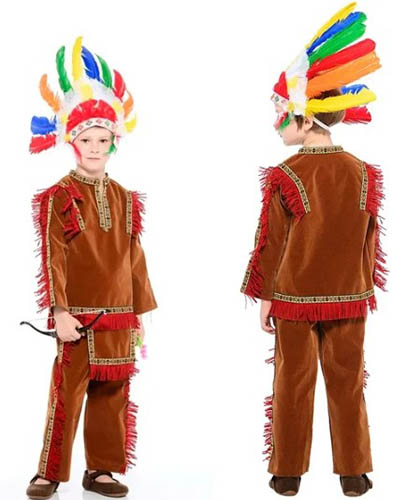
To decorate the outfit, decorative items in bright blue, green, and red colors will come in handy. The costume will be complemented by Indian weapons: a bow and arrows, a tomahawk or a knife.
Suit for a boy
The simplest and A quick way to create an Indian costume is to use a T-shirt and shorts that your child has in his wardrobe. (or jeans, trousers). Light-colored clothes will match the idea - white, beige, cream, light gray, light brown. It is enough to decorate a T-shirt and pants with fringe brown in color, imitating animal skin.
Fringe can be purchased ready-made or cut from fabric. Fringe is easy to assemble from knitting threads, sewing them onto a thick narrow tape. On pants, fringe is sewn along the outer side seam, on a T-shirt, it is placed along the shoulders and sides. A bright tape with a geometric pattern will help highlight the fluffy fringe.
You can also decorate your outfit with an ethnic pattern. It is convenient to apply the pattern with fabric paints or acrylic paints, in this case they will not smear or leave marks on the skin. Having printed out a stylized Indian pattern, the picture is transferred to the fabric and painted.

In this case, it is necessary to put a cardboard rectangle inside the T-shirt to avoid staining the back of the garment.
The child usually copes with coloring successfully. The boy can use his imagination and come up with his own ethnic symbols: such signs as waves, zigzags, circles, triangles, schematic images of feathers and animals are suitable for Indian clothing.

An apron is put on over the trousers. It is a rectangular piece of fabric with a belt that is tied at the back. The apron is also usually decorated with geometric patterns and fringe.
The Indian costume for a boy will become even more elegant if you make a poncho. To do this, you will need a square piece of fabric measuring 0.7 x 0.7 m. The fabric is folded, and a hole for the head is cut in the center.
The perimeter of the cut is trimmed with fringe, and the bib in the center is decorated with various decorative elements:
- coins;
- shells;
- large beads;
- a design applied with paint;
- pieces of fur;
- beads;
- feathers.
It is not difficult to sew a shirt in the Indian style for a boy. The pattern is a rectangular panel, the height of which is equal to the length from the shoulder to the knee of the child, and the width is 1.5 times the chest volume. The sleeves are also cut in the form of rectangles.
This shirt is decorated with fringe, which can be cut from the same material, as well as other finishing materials.
Costume for a girl
The female Indian outfit includes a tunic and pants, which can be replaced with a long, loose dress. A simple tunic pattern is a rectangular piece of fabric, where the height is determined by the length from the child's shoulder to the knees, and the width is determined by the chest circumference + 10-15 cm. Semicircular necklines are made at the top.

With this cut, it is enough to sew the shoulder and side seams - and the tunic is ready. The bottom part can be left flat or cut out in the form of a triangle, the acute angle should be in the center of the front part.
The costume is decorated with fringe, which is sewn on:
- on the shoulders;
- breast;
- along the bottom of the product;
- into the side seams.
The Indian costume for a boy or girl should be richly decorated, so beads are woven and secured into the fringe, and complemented with a multi-colored braid called "bindweed" or "centipede". A tunic looks beautiful, the main decorative element of which is a bib. For this, a triangle is cut out and decorated with beads, braid, embroidery, and feathers.
The bib with a pattern in the form of an animal's face or a bird's head looks original. The triangle is sewn onto the front part of the tunic.
Instead of a bib, you can make a loincloth that is worn over the tunic. The bandage can be made from a piece of fluffy fabric that imitates wool. The dimensions of the loincloth are determined by the parameters of the child: the length from the waist to the middle of the thigh and the volume of the hips.
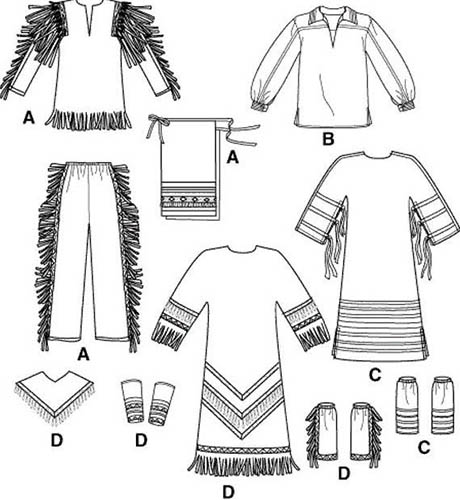
The headband can be cut out in the form of several triangles sewn together, or made asymmetrical. The unusual accessory will be complemented by beads, round and oblong, fixed on the protruding parts in the form of pendants. The headband is decorated with a belt on top. It can be made from a piece of fabric and richly decorated with beads, feathers, braid.
A girl's costume can consist of the following elements:
- trousers (jeans) with fringe sewn onto the sides;
- braided leather belt;
- light T-shirt;
- vest, the bottom and front of which are decorated with fringe.
Gaiters will complete the costume; they are easy to sew from knitted fabric. The upper part of this detail is decorated with tassels with fringe or feathers, beads.
Headdress
The Indian costume for a boy and a girl is complemented by a headdress. The simplest option is a narrow headband that holds the hair. However, a complex multi-component headdress made of feathers looks more advantageous; for this, both natural feathers and fabric, paper, and felt are useful.
From feathers
The brightest and most beautiful roach is made from natural feathers. Feathers can be purchased at craft stores. Choose feathers of natural colors. Another option is to collect feathers from domestic or wild birds. In the latter case, they must be steamed, paying special attention to the rods.

The easiest way to make a fancy warrior or chieftain headdress with your own hands is to sew feathers onto a strip of fabric, the length of which is equal to 2 times the volume of the child's head. The feathers are arranged in a semicircle in the center or on the side. Then a bright braid is sewn onto the fabric on top, which will disguise the seams. Such a roach can be tied at the back of the head.
A more complex option involves the following steps:
- Sew a hat from thin elastic fabric. To do this, sew the edges and top of a strip of fabric 20 cm high and 5-7 cm longer than the size of the child's head.
- The stem of each feather is wrapped in bright fabric up to ¼ of its height, and the fabric is secured with glue or sewn.
- The feathers are attached to the hat so that the rods form a semicircle.
- The places where the feathers are attached are covered with a forehead piece embroidered with beads.
- Round pieces of fabric are sewn onto the cap as temple pendants, and feathers and beads are attached to cords underneath them.
Instead of a hat, in this case, you can use a headband. Acrylic paints intended for work on fabric will come in handy to decorate the headband. Using paints, you can draw geometric patterns or dot painting that imitates beads.
For another option for making a headdress from feathers you will need:
- polypropylene fabric size A4 (2 sheets);
- black felt;
- feathers.
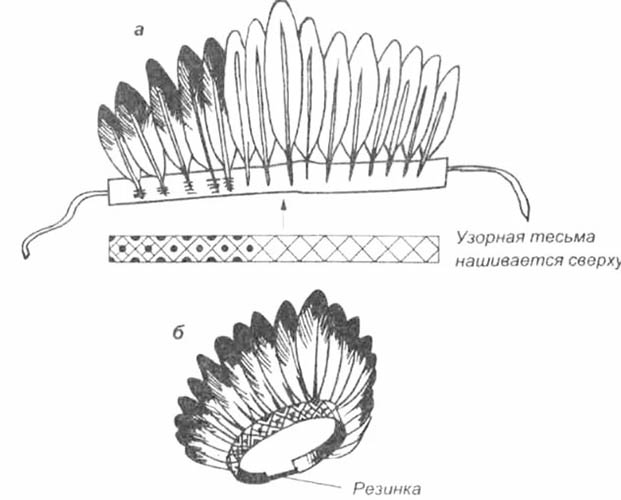
On a sheet of paper, cut out a pattern of a roach similar to a kokoshnik. The height above the forehead does not exceed 20 cm, the ends of the roach should be above the temples. Transfer the pattern to polypropylene fabric, cut out 2 pieces.
In the corners of the roach, holes are made through which a cord is passed, with its help the headdress will be held on the head. Two felt rectangles are glued to the front part of one half of the kokoshnik, placing them on the sides. The upper part of the element is shortened by 5-6 cm.
The feathers need to be wrapped in black felt rectangles measuring 7x10 cm. To do this, the feather shaft is coated with glue and wrapped in fabric. To ensure that the material holds firmly, it is additionally secured with a thread, wrapping the fabric with it.
In the next step, the feathers are laid out on a polypropylene element: the tallest ones are placed in the center, the smaller ones are placed at the edges. This is how a semicircular shape is formed.
The feathers are glued in such a way that the felt is located 5-7 cm above the base, and the feathers are tightly adjacent to each other. The feathers are also glued to the side felt rectangles, placing them at an angle to the center.
The entire structure is coated with glue, and a second element made of polypropylene fabric is placed on top. After the parts have dried, short fluffy feathers are glued to the upper part of the front side.
All that remains is to attach the Indian headdress to the headband. To do this, cut a strip 5-6 cm high and 40-50 cm long from a dark, thick fabric. Apply a geometric pattern with paint: to create the appearance of sewn-on beads, use the dotted paint application method.
For 2 temple pendants, cut 4 circles of 6-7 cm in diameter from black felt (2 front and 2 back). Threads with tied feathers or beads are glued to the back circles, and the front circle covers the gluing area. A pattern is painted onto the front circles.
Decorative pendants are fixed to the bandage on the temples. It remains to connect the bandage to the headdress, this can be done with glue.
Made of fabric
Roach can be made of felt. For this, you will need felt in 5 colors. A wide headband is cut out of black felt. It is convenient to make a headband 10-20 cm in size so that the front part is located in the center of the forehead. A wide elastic band is attached to the edges of the headband, this will allow the child to quickly take off and put on the headdress.
A pattern of an oval, slightly elongated feather is made in 3 sizes: 1 large, 2 medium and 2 small. It is enough to use felt of 2-3 colors. Feathers are cut out in double quantity. Each feather is sewn on the front part on a machine or by hand with black threads: the pattern should imitate a feather shaft and diverging feathers. Then the elements are sewn together so as to hide the back of the embroidered part.
Feathers are sewn onto the headband, and an ornament made of geometric elements is sewn onto the front part. Thin strips of felt with beads sewn onto them can be used as pendants.
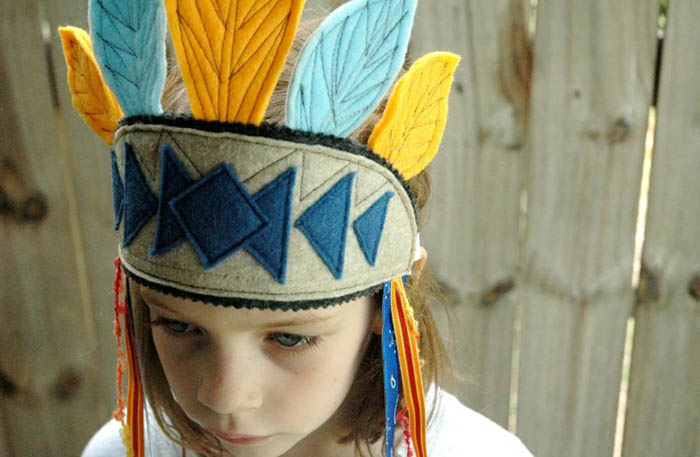
Feathers for an Indian headdress can be made from calico. To do this, transfer the pattern onto the fabric and cut out the feathers. Fold the feathers in pairs, inserting a wooden skewer or cocktail stick inside and smearing with glue. The edges of the feathers need to be fluffed up, pulling out the threads a little.
Then the feathers are dyed, for this you can use natural bird tones - gray, olive, black, white, greenish, brown. The resulting feathers are sewn onto a headband made of thick fabric. The rods are fixed with glue or sewn on, and decorative braid is sewn on top of them.
From paper
The Indian costume for a boy and a girl can be supplemented with a headdress made of paper. For work you will need colored paper or thin finely corrugated cardboard.
The principle of roach construction is as follows:
- Cut feathers out of paper using a stencil or template. The feathers should be of different heights (from 7 to 15-20 cm), but the same width (2.5-3 cm). It is recommended to draw the core and individual feathers. You can bend the feathers in half, then straighten them out and make cuts that imitate feathers to make them look like real ones.
- Cut out the hoop, glue or sew the edges. The diameter of the hoop matches the volume of the child's head.
- Glue the feathers onto the hoop. You can place them in the center in a semicircle or fill the entire front part of the hoop with feathers.
- Decorate the front part of the hoop with an applique or a picture, glue on a braid or embroidery to cover the places where the feathers are attached. Attach pendants to the temples, they can be made from thin cords, strung with beads or beads.
You can also make a roach by placing feathers on the back of the hoop, in which case 2-3 feathers will be enough.
Accessories
Numerous bracelets and beads were an essential element of everyday and festive attire for Indians.
How to make original jewelry:
| Materials | Result | Manufacturing process |
| Pasta, gouache or food coloring, spandex cord or waxed thread | Bracelet, beads | To quickly color the pasta, pour food coloring into a jar, add the pasta and shake. Then dry the pasta on a baking sheet or sheet of paper. You can color it by hand with gouache. To ensure that the paint holds well and does not stain your clothes, it is advisable to spray the pasta with hairspray. The pasta is strung on a thread or cord. |
| Feathers, colored cord | Beads | The feathers are tied to a thread by the tip. The alternation of feathers and beads looks beautiful. |
| Plastic bottle, colored bags or threads | Bracelet | Cut a 3-4 cm wide hoop out of the bottle, adjust the length to the size of the child's hand (if you need to make it bigger, cut the hoop, add a piece of plastic and secure with tape). Wrap the hoop with strips of colored bags, keeping the pattern geometric. |
| A piece of leather, acrylic paints, cord, feathers | Breast decoration | Two circles with a diameter of 5-7 cm are cut out of a piece of leather. A piece of cord of such a length is placed between the circles so that the decoration fits in the center of the child's chest. The cord is fixed with glue. Feathers are glued between the circles so that they hang freely; shells and coins suspended on threads can be added. The circles are glued or sewn together. The front part of the decoration is dotted with paints. |
| Braided cord (soutache, clothesline, polypropylene twine) | Using the macrame technique, you can weave a chest decoration in the form of an owl, an animal's face and sew beads in place of the eyes. The geometric pattern looks interesting. The pendant is attached to a long cord so that the decoration is located in the middle of the child's chest. | |
| Felt, beads, flat cord | Elements are cut out of felt (the shape is an Indian cucumber), each element in 2 copies. The elements are sewn together, a little padding polyester is put inside to give volume. Then the elements are sewn onto the braid, alternating with beads. |
If the child has long hair, it can be loosened and individual strands can be braided into thin pigtails, with beads attached to the ends. A hairstyle of two loose braids thrown over the chest looks beautiful. Indian weapons - a tomahawk, spear or bow - will complement the outfit.
An Indian costume will come in handy for a themed birthday or New Year's event. An Indian-themed party will be a memorable event for a boy or girl and their friends. Making an outfit with your own hands will not take much time, it is especially exciting to create an Indian costume together with your child.
Video about Indian costume
Master class: how to make an Indian headdress from A4 paper – Roach:
